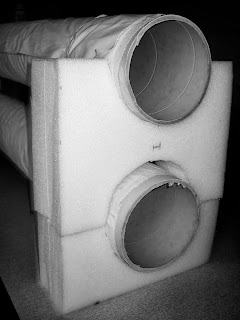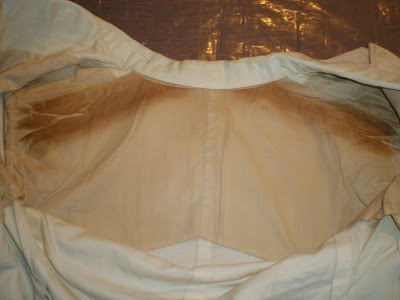How to Store Your Flag parts 1, 2 and 3 have been met with lovely comments from old friends and colleagues as well as some new friends and colleagues, I'm so glad these were useful. In this series of posts on storage we mentioned many materials. We thought that it would be helpful to just post the entire list of materials in one location, so as promised, below is the glossary - enjoy!
Acid-free tissues, papers and boards:
Acid-free or neutral pH materials should always be used. These materials are made of 100% cotton fiber, whereas acidic papers are made from wood pulp. Questionable materials can be tested with pH indicator pens. These pH pens can be purchased at archival supply, or craft and fabric stores.
The blue/gray boards have a buffering agent added. It is generally an alkaline substance with a pH over 7. This reservoir neutralizes the acids that may be absorbed from the environment around. The alkaline residues could react with protein materials, like wool, hair, leather and some photographs.
Buffered materials can be used for Cellulose materials, like paper, cotton, and linen, but
not with proteins. It has been observed that being in contact with buffered tissue also affects some dyes. Therefore care is needed in choosing the correct material.
Use for interleaving, solid supports, and in storage containers
Adhesive Tapes (Double-sided):
As with plastics, tapes need to be chosen with care. A product by 3M, #415 double-coated tape has been found to work best. It is pressure sensitive made with a high tack acrylic based adhesive on a polyester carrier. Products #924 and #969 are acrylic-based adhesives with no carrier. Both are non-yellowing, inert and reversible with solvents. Both tend to cold flow.
Use these tapes only in construction of storage supplies, like encapsulating flat paper items, but not placed directly on the artifact.
Batting:
Look for polyester needle-punched batting. This batting is formed mechanically by fiber entanglement using barbed needles. The other commonly found battings are made with resins that bond the fibers. The resins have been found to yellow and then can transfer onto artifacts. The packaging will frequently be marked if one is purchasing from a fabric store. Polyester materials resist mildew.
Use batting for padding-out and filling in order to obtain the desired profile of a mannequin. It can hold shape even under weight. Best if secured with stitching. Can also be used as stiffening, like at the bottom of a petticoat. Note that all battings need to be covered.
Coroplast:
A rigid, lightweight, polypropylene/polyethylene copolymer corrugated (or fluted) sheet. It is lightweight and fairly strong. The archival grade does not have any anti-static or ultraviolet inhibitor additives. This grade is more expensive than the standard grades. Coroplast can be cut with a utility knife. It can be bent with heat, or scored. Sheets are available in several thicknesses, 2-6 mm, and in several colors. When used for storage box tray construction, the sides can be secured with brass clasps, and sewn with heavy weight cotton, linen thread or twill tape. Corners can also be secured with hot melt glue rivets.
For display, one can cut it into forms to support lightweight textiles. Cover Coroplast with batting and stockinette or exhibition fabric.
Ethafoam:
Ethafoam is a Dow Chemical Co. trade name for polyethylene, a thermosetting plastic. Ethafoam is a closed-cell foam with a smooth surface. The cut edges are softer than other foams, like Styrofoam. It is easily cut with knives, and wood working tools.
It is best to look for Ethafoam manufactured by Dow. Other foams have been found to include additives and stabilizers that can cause problems and yellowing.
Fabrics:
It is best to use unbleached 100% cotton fabrics, like muslin, stockinette, flannel and twill tape. Any fabric that is used with collection needs to be washed in hot water.
A word of caution about fabrics; many have finishing treatments like flame-retardant or durable press. These types of finishes need to be avoided and removed with hot water washes. Wool is also a fabric not to be used for exhibitions or storage. It can tarnish silver in closed environments and attracts insects. If felt is to be used, look for polyester types.
Foam-Core:
A Styrofoam sandwiched between paper or plastic. There are both archival and non-archival products available. These come in several thicknesses. Avoid using cores made of beaded Styrofoam, as the beads can easily break apart at the edges. Best to use as a temporary material. Not suitable for long-term storage.
Hook and Loop Fasteners (Velcro):
Not all-generic Velcro is made from the same formulation. Some forms of Velcro have been found to have adverse effects to the textiles to which they have been attached. It is suggested to purchase it in large batches and test it. Always attach the soft side to the textile artifact with a separator of webbing or a muslin tab.
Avoid using Velcro with pressure-sensitive adhesive.
Hot Melt Glue:
This is a thermoplastic adhesive that is applied in the molten state and forms a solid when cooled. There are several different formulations. The ethylene/vinyl acetate copolymer is generally suitable for construction of mount supports. 3M’s #3764, Bostik’s Thermogrip #6363 and Evode’s Evo-Stik #7702 have been found suitable.
The glue is very hot! Care is needed not to burn oneself. It adheres to most surfaces. It can be difficult to use with smooth surfaces. Can cause damage to rare earth magnets.
Marlvelseal #360:
A foil composed of layers of nylon, aluminum and polyethylene. Provides a good barrier that resists transmission of water vapor and gases. The polyethylene side or dull side can be heat-sealed and can conform to curved shapes with a tacking iron. Use Marlvelseal to seal questionable materials for display and storage.
Mylar:
Mylar-D is a polyester, transparent film. It is a strong, inert and dimensionally stable film that is very clear. It comes in different thicknesses. Look for virgin polyester, type D made by DuPont Co. Mylar does create static charge.
Use to encapsulate and separate materials.
Plastics:
Not all plastics are the same. Many have plasticizers that make the plastic material more flexible. Over time the plasticizer causes deterioration and should be avoided. Other additives that can be included and can cause damage are slip and anti-static agents. Dry cleaning bags turn yellow due to BHT that is added to the polyethylene.
Good plastics are made from polyethylene, polyester, polypropylene and acrylics. These are the most commonly found. Most archival products found in catalogs will be made of one of these types. Other less common plastics are: polytetrafluoroethylene, polycarbonates and silicone.
Plastics that cause adverse effects are materials and rubbers containing sulfur-vulcanizing agents.
Stockinette:
This comes as 100% cotton unbleached or 100% polyester surgical tubing. Both need to be pre-washed. It is used to cover mounts, tubes, etc. It is particularly useful in making arms and other sausage like shapes. It provides sufficient tension to lower the amount of stitching needed.
Tyvek:
A spun bonded olefin is a high-density polyethylene fiber bonded under intense heat and pressure, manufactured by DuPont. This product has many good qualities: it is strong, non-buffered, has low resistances to water and mold. Tyvek both protects artifacts from dust while allowing for air circulation. It is smooth with no binders, fillers or buffers. It is low linting, and resistant to water and chemical-aging. Some solvents cause swelling. Housewrap may contain ultra-violet stabilizers. It comes in a range of weights. The weight that is commonly used is Type 1443R. This material can be washed in the washing machine several times. It is good for dust covers and wrapping collections. Can be seamed or glued. However, is not a good barrier for preventing acid migration.
_____________________________
Gwen Spicer is an art conservator in private practice. Spicer Art Conservation specializes in textile conservation, object conservation, and the conservation of works on paper. Gwen's innovative treatment and mounting of flags and textiles is unrivaled. To contact her, please visit her website.
Look for Gwen's book, "Magnetic Mounting for Art Conservators and Museums", available in 2018.

























